
Swastika is a small community founded around a mine site in Northern Ontario, Canada in 1908. Today it is within the municipal boundaries of Kirkland Lake, Ontario. It has frequently been noted on lists of unusual place names.
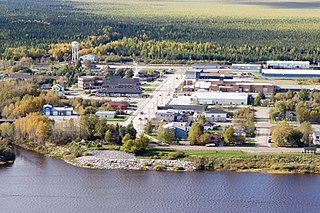
Moosonee is a town in northern Ontario, Canada, on the Moose River approximately 19 km (12 mi) south of James Bay. It is considered to be "the Gateway to the Arctic" and has Ontario's only saltwater port. Nearby on Moose Factory Island is the community of Moose Factory to which it is connected by water taxi in the summer and ice road in the winter.

Cochrane is a town in northeastern Ontario, Canada. It is located east of Kapuskasing, northeast of Timmins, south of Moosonee, and north of Iroquois Falls. It is about a one-hour drive from Timmins, the major city of the region. It is the seat of Cochrane District. The town's population is made up of about half anglophone and half francophone residents.

Montreal Locomotive Works (MLW) was a Canadian railway locomotive manufacturer which existed under several names from 1883 to 1985, producing both steam and diesel locomotives. For a number of years it was a subsidiary of the American Locomotive Company. MLW's headquarters and manufacturing facilities were in Montreal, Quebec.
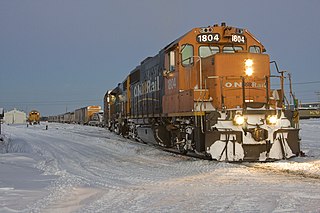
The Polar Bear Express is a Canadian passenger train operated by the Ontario Northland Railway in Northern Ontario. Service was introduced in 1964. While designated as a passenger train, the Polar Bear Express also carries freight and is equipped with specialized equipment including boxcars for canoes, snowmobiles and all terrain vehicles. There are also baggage and express cars. In the past a special car existed for canoes but now these are carried in regular boxcars.
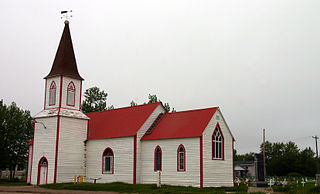
Moose Factory is a community in the Cochrane District, Ontario, Canada. It is located on Moose Factory Island, near the mouth of the Moose River, which is at the southern end of James Bay. It was the first English-speaking settlement in lands now making up Ontario and the second Hudson's Bay Company post to be set up in North America after Fort Rupert. On the mainland, across the Moose River, is the nearby community of Moosonee, which is accessible by water taxi in the summer, ice road in the winter, and chartered helicopter in the off-season.

Englehart is a town in the Canadian province of Ontario, located on the Blanche River in the Timiskaming District.

Washago station is a passenger railway station in the community of Washago, Ontario, Canada, part of the Township of Severn in northeastern Simcoe County. The station is located immediately south of Simcoe County Road 169, east of Highway 11.

The Northlander was a passenger train operated by the provincially-owned Ontario Northland Railway in southwest and northeast Ontario, Canada. In 2012, rail service was discontinued and replaced with express bus service. Rail service will be reinstated in 2026 with an expanded route, greater frequency, new Siemens Venture train sets manufactured by Siemens Mobility Ltd., and various track and station upgrades. The new bi-directional route will run up to seven days a week from Toronto Union Station to Timmins, with an additional new rail connection from Timmins to Cochrane and express bus service from Matheson to Cochrane Station.

The Ontario Northland Transportation Commission (ONTC), or simply Ontario Northland, is a Crown agency of the Government of Ontario responsible for providing transportation services for passengers and goods in Northern Ontario. It reports to the Legislative Assembly of Ontario through the Minister of Transportation.

Ontario Northland Motor Coach Services is an intercity bus service operated by the Ontario Northland Transportation Commission, a Crown agency of the government of Ontario, Canada. Ontario Northland Motor Coach Services operates passenger and parcel transportation service in northern Ontario, with additional routes connecting northern Ontario to the Greater Toronto Area, Winnipeg, and Ottawa.
Bracebridge railway station is located in the community of Bracebridge in Ontario, Canada. The railway station was a stop for Northlander trains of Ontario Northland Railway until service was discontinued on September 28, 2012.

Huntsville station is located in the town of Huntsville, Ontario.
South River Railway Station is located in the community of South River in Ontario. The station was originally constructed by the Northern and Pacific Junction Railway, a subsidiary of the Northern and Northwestern Railway, in 1884. It was subsequently owned and operated by the Grand Trunk Railway and Canadian National Railways. It was a significant station stop along the historic route connecting Toronto to North Bay, and the Canadian Pacific Railway (1885). Transcontinental trains traveling between Toronto and Vancouver once frequented the station. It is likely the oldest wooden railway station in north-eastern Ontario. It is now a community heritage building in the town of South River.
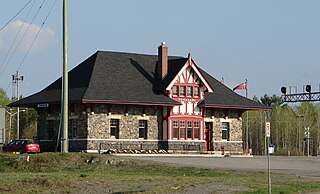
Temagami station is a railway station in Temagami, Ontario, Canada.

Englehart station is located in the town of Englehart, Ontario, Canada. It was a station stop for Northlander trains of Ontario Northland before service was discontinued in 2012. In 2021 the Government of Ontario announced plans to restore service using ONR from this station north to either Timminis or Cochrane by the mid 2020s. The modern two-storey station replaced an earlier station. Englehart was the halfway point for the Ontario Northland and served as the engineer swap-out point. The Building itself houses all the signal services for the Northern route. Englehart maintains a locomotive engine to be running 24/7 in case of an emergency on both side of Englehart, same with Cochrane and North Bay respectably. Englehart also has 11 storage tracks and a machine shop for repairs.

Matheson station is located in the township of Black River-Matheson in Ontario, Canada.
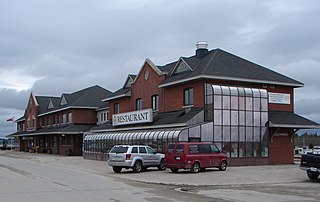
Cochrane Station is an inter-city railway and bus station located in the town of Cochrane, Ontario Canada operated by the Ontario Northland Railway (ONR). It is the southern terminus of the Polar Bear Express service to Moosonee and former northern terminus of the discontinued Northlander route. The station is located in downtown Cochrane, south of the intersection of Railway Street and 7th Avenue. Its main entrance faces north to Railway Street. South of the station building, trains call at a low level platform adjacent to the ONR Island Falls Subdivision.

Moosonee station is a railway station in Moosonee, Ontario, Canada operated by the Ontario Northland Railway. It is the northern terminus of Ontario Northland's Polar Bear Express, located about 12 miles south of the shore of James Bay on the north bank of the Moose River. It consists of a single storey station building, sheds, and a small train yard.

Hawker Siddeley RTC-85/SP/D were a series of railway coach and diesel multiple units manufactured by Hawker Siddeley Canada for GO Transit, largely based on the H-series subway cars that they built for the Toronto Transit Commission.



























